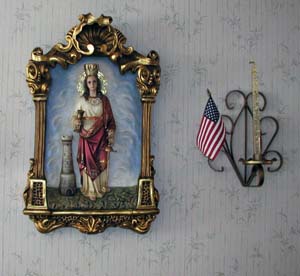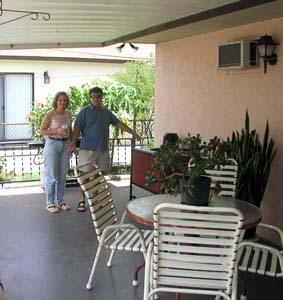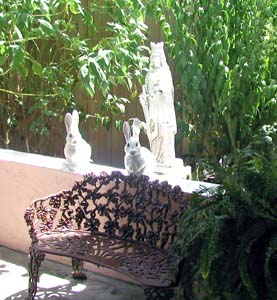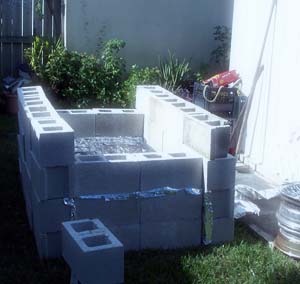When Cubans arrived in Miami, the prevalent Spanish-style architecture of the houses made them feel right at home. However, most Cuban families added a few "finishing touches" to their new houses to make them look just like those they left behind in Cuba.
As we drive up to the house, the first thing we notice is the lack of large trees in the front yard. The owner needs the extra space for the extended family's several household vehicles. The owner may also have reserved a spot for the renters of the small efficiency apartment that he has carved out of the garage or added to the back of the house, a typical feature in this neighborhood.
As crowded as the front yard might be with automobiles, there always seems to be room for a saint crypt and a tinajón. The crypt houses one of the Cuban Saints: Caridad, Lázaro, Regla, or Barbará, and sometimes all four. At some houses, a small statue of an old African man representing the orisha Elegua might also welcome us. The tinajón is a huge, brown earthenware pot. Here we see it displayed as it is always presented, tipped on its side so that the open top faces the street with its bottom fourth buried in the soil.
Walk up the driveway and take note of the house color. Gone are the typical chalky white, light pink and pale aqua facades that were prevalent in Miami in the 1960s. These have been replaced with bolder tropical colors: mango green, papaya yellow and reddish orange mamey. The homeowner added wrought iron bars in the doors and windows not for security, but to duplicate the Spanish style common in Havana.
Step inside the front door and we are greeted by an elephant figurine sitting on the floor, posed with its rear end toward the door for good luck. The elephant rests, not on carpeting or a wooden floor, but on a Spanish tiled floor. Step carefully around abuela, as she mops the already sparkling tile with a traditional Cuban mop, the palo de trapear, a mop handle that has a wooden bar attached at the bottom to form a "t." To operate this cleaning machine, one merely wraps an old towel or blanket ("frazada" in Spanish) around the bar. Abuela is working the palo expertly and the strong scent of Mistolin, an all-purpose cleaning fluid that she uses on everything from tile floors, to bathroom fixtures and even in the laundry, fills the air.

On our right is the living room, a space that the family so rarely uses they might have forgotten it years ago if not for daily mandatory cleanings. The room features several pieces of fancy furniture, all covered in plastic and reserved for only the most honored guests. There are houses where this furniture might feel the weight of a human being just once a year, but not having such a room in the home is unthinkable!

Walk on back through a formal dining room that also sees little use and enter the Florida room. A distant cousin to the screened-in porches of the north, the Florida room has glass windows and air conditioning and is typically tacked onto the back of the home like an afterthought. Here we find a comfortable couch, a couple of cane-backed rocking chairs, a color TV, and a small stereo.
First communion, wedding, and graduation photos adorn the walls. There are formal pictures of the children and grandchildren taken at Sears, and at least one painting or print of a Cuban countryside scene, especially anything that features the ubiquitous Poinciana tree. On top of the TV, a pair of Spanish Dancers stands forever frozen in a flamenco pose. A ceramic black panther crouches on the coffee table as if ready to pounce on an unsuspecting visitor. A shelf in the corner displays the family's cherished Lladró figurines, ideally purchased on a vacation to the mother country, Spain.


From the book, "Miami Lost – Miami Found: The Cuban Culture of Miami Then and Now" (Unpublished)
Step out through the back door of the Florida room onto a patio covered with an aluminum awning. The patio features a table for playing dominos, several patio chairs, and a gas barbecue with side burner. The latter is an essential item to have during hurricane season when entire neighborhoods may lose power for weeks. Look at the yard filled with mango, papaya, bitter orange, avocado, banana, and guava trees.
Step back inside and look at the eat-in kitchen. Since it is afternoon, there is always a pot of black beans or picadillo quietly bubbling away on the back of the stove. A print of "The Last Supper" hangs over a Formica-topped kitchen table, always covered with a clean and pressed tablecloth for every meal. Also on the side of the kitchen cabinet is a calendar with the Sacred Heart of Jesus or the Virgin of Caridad. The toaster perpetually sits out on the countertop, but is never left uncovered. Here we see one draped with a crocheted Santera doll sporting a basket of fruit on her head.
A narrow hallway leads us past the small bathroom to the master bedroom. This is strictly the woman's domain, and there is scant evidence that the husband ever uses this room. The only sign of masculinity is perhaps a small open wooden box, lined with felt and holding a couple of cologne bottles or some small personal items. Instead, an elaborate silver tray dominates the dresser with rococo perfume bottles, talcum containers, and a fancy clock—all part of a set that the wife may have purchased at La Tijera or any of the dozens of local Cuban furniture stores. Several first communion, baptismal, and funeral cards plus two aging black and white photos of family still in Cuba are tucked into the tray. On the wall near the dresser is an inexpensive print of Goya's "La Maja Desnuda," a popular choice for the privacy of the bedroom away from the prying eyes of Tía Anacleta or the parish priest.
Now the formal part of our tour is over, but since this is a Cuban household, the family will not allow us to leave without joining them for a delicious dinner. As the sun sets, we gather with the family on the patio for cold drinks and a game of dominos as we enjoy the cool night air.
Behind a small shed in the back of the yard, next to the privacy fence, we see stacks of concrete blocks and a steel mesh frame. These are the makings of a Cuban pig roaster and several times a year the men of the family will stack the bricks in the backyard, strap a whole hog into the frame, and spend the day roasting the pig in the traditional Cuban style.
Tucked into a corner at the back of the house is the family's open-air laundry room: a washer and possibly a dryer, although the preferred clothes drying method is the clothesline, here hung from the side of the house to a pole in the yard. The back of the house also includes an additional appendage: a self-contained "mother-in-law" quarters with its own small kitchen and bathroom.




Drinks | Appetizers | Salads | Main Dishes
Soups | Side Dishes | Desserts | Index
